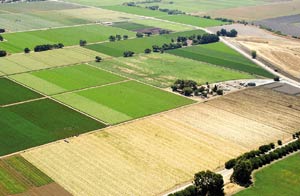The latest plans to create a Coyote Valley mini-city remain far
from perfect and very
”
premature,
”
according to South County’s top politician and an environmental
group fighting the development.
Morgan Hill – The latest plans to create a Coyote Valley mini-city remain far from perfect and very “premature,” according to South County’s top politician and an environmental group fighting the development.
“There will most likely be lawsuits. It’s up in the air if this thing will ever happen or not,” Santa Clara County Supervisor Don Gage said this week of the Coyote Valley Specific Plan, which aims to bring 25,000 homes, 50,000 jobs and 80,000 residents to the area between Morgan Hill and San Jose.
“They’re certainly not satisfying the county,” he added, “in terms of roads and who’s going to maintain and repair them, who’s going to provide parks and the environmental community in general. They’re developing on prime agricultural land.”
Gage’s comments come before an Oct. 15 meeting where he and other members of a San Jose Coyote Valley Specific Plan Task Force review the latest plans to develop a live-work community on 7,000 acres between San Jose and Morgan Hill. The task force sent San Jose planners back to the drawing board last month, calling for a new phasing plan that would generate enough cash to finance a man-made lake, transit hubs and other features officials see as vital to creating a vibrant community.
The amount of home construction targeted in the first phase of the project represents the biggest change in the latest round of recommendations, though San Jose planners say the changes are not that big.
“This plan is not that different,” said Salifu Yakubu, San Jose’s principal planner on the project. “The phasing program is different, it’s more refined than the one we discussed before. In terms of the cost numbers, we’re still figuring that out. We don’t have the numbers quite refined yet, but they will be ready Monday (for the task force meeting).”
Prior cost estimates placed the figure for roads and other infrastructure at $1.2 billion, and San Jose officials hope that allowing more home-construction up front will generate that cash.
“It’s going to take a lot of money to put together the infrastructure that we need,” Yakubu said. “What we’re going to do is come up with phases to be sizable enough to build sufficient infrastructure.”
The latest plans peg housing development to job creation at a one-to-two ratio, with developers allowed to construct 10,000 homes in the first phase of development. They cannot build any other homes until 20,000 jobs are first created in the area. Once the job target is met, the process repeats itself in a second phase with identical numbers. The third and final phase of construction, under the latest recommendations, would involve the creation of 5,000 homes and 10,000 jobs.
The task force’s phasing debate represents a sideshow to San Jose’s broader efforts to revise the city’s growth vision for Coyote Valley, according to Brian Schmidt, an environmental activist with the nonprofit Committee for Green Foothills.
San Jose officials plan to revise their 2020 General Plan next year and San Jose Mayor Chuck Reed has said that he wants those revisions to include more so-called “triggers” for home construction, according to Schmidt. The current general plan “trigger” requires the creation of 5,000 jobs in Coyote Valley before a single home can be constructed. But once that job threshold is met, the plan allows for unlimited housing development, Schmidt said.
The task force’s latest phasing plan represents a slight improvement on the general plan trigger, but it’s “still not good enough,” Schmidt said.
“It leaves open the possibility for residential development outpacing the jobs that the residential development is supposed to serve,” he said. “The outcome of that will be to make this a place that theoretically is providing both jobs and housing, but in reality is just a residential housing money-maker for land developers.”
San Jose planners say, however, that the money generated by housing development is the key to making the community livable and avoiding a bedroom community that clogs highways and pollutes air. An August staff memo states that “the land value associated with 5,000 jobs is not considered sufficient to fund the key ‘place-making’ infrastructure and therefore this requirement would likely delay the overall early activation of development.”
The so-called “place-making” features include a lake and park, a realigned and extended Santa Teresa Boulevard, a realignment of Fisher Creek and a Caltrain multi-modal station. New cost estimates on those features are not yet available, though Yakubu said they will be ready in time for the Oct. 15 task force meeting.
“We think that the immediate effect of their construction would help the value of the place and would serve as a catalyst for others to develop there,” he said.
Yakubu insisted that the construction, which is not expected to be completed for four more decades, would not be quicker even though more homes can be constructed in the first phase.
“The phasing plan does not have anything to do with the pace of development,” he said.
While the task force tackles the phasing issue, San Jose planners will continue grappling with a mountain of questions on the environmental study underpinning the Coyote Valley plan. The city, which received more than 1,300 pages of scathing criticism on the draft environmental study, expects to release a memo on possible revisions to the draft study.
“It’s a little unclear what are timing will be on that,” senior planner Susan Walsh said. “But we’re working on improving it, and recirculating it thereafter.”
Gage, who represents South County and serves as an appointee on the Coyote Valley task force, was skeptical about the new plan’s ability to win supporters.
“There is going to be a lot of complaints that they’re not going to be able to mitigate,” Gage said. “Traffic, air quality, parks … one right after the other.”







